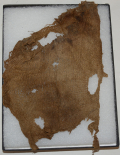site search
online catalog
INDIAN WAR SOLDIER’S MITTEN PIECE FROM FORT PEMBINA, ND

$65.00
Quantity Available: 1
Item Code: 1052-621
Shipping: Determined by Method & Location of buyer
To Order:
Call 717-334-0347,
Fax 717-334-5016, or E-mail
This comes from the excavations at Fort Pembina, occupied 1870-1895, where cold weather in winter months might well be a concern. The army began issuing mittens in 1873. Before that men were left to their own devices in protecting their hands in cold weather. The 1873 pattern is not well described but was likely similar to the 1876- a gray woolen yarn, doubled and twisted, with thumb and forefinger formed. In this case not enough is preserved to be sure of the pattern and it could be slightly later, but is still of the Indian War period. The fabric is very similar to that used in socks recovered from the site, which preserved leather and cloth in very good condition from the wet, anaerobic soil of the dig (conducted on private property with the owner’s permission,) though in this case the color has shifted to an light brown with dark brown stains.
Situated in the Red River Valley in North Dakota near the Canadian border, Fort Pembina was established in 1870 and in operation until 1895. Trading posts existed earlier in the area as part of the fur trade, and the first U.S. military post there was temporary- manned by a detachment of Minnesota troops in 1863-1864 following the 1862 Sioux uprising. In March 1870 a new fort was established south of the Pembina River and about 200 yards west of the Red River, completed by July and named in honor of Gen. George H. Thomas. The name was changed to Fort Pembina in September and the initial garrison consisted of two companies of the 20th US Infantry. Their main duty was to provide security for settlers worried about Sioux returning south from Canada, but the troops were more occupied with escorting boundary surveys along the Canadian border and preventing Fenian raids heading north into Canada.
The fort included enlistedmen’s barracks, officers’ quarters, guard house, ordnance storehouse, company kitchen, root house, laundress’s quarters, quarters for civilian employees, hospital and hospital servant’s house, a barn for the “hospital cow,” quartermaster and commissary offices and storehouse, stables, wagon shed, etc. The garrison reached peak strength in 1878 af 200, but the average was about 125 enlisted men and 8 officers. An October 1885 return listed 97 men, 2 field pieces, 1 mountain howitzer, 100 rifles, 19 pistols, 23 mules, and 9 wagons. By 1890 the post had just 23 men, and after an 1895 fire destroyed some 19 buildings it was decided to abandon the fort rather than rebuild, the last detachment left in September. The property was turned over to the Interior Department and later sold in 1902.
Mittens, like other useful army surplus, were seldom preserved. Even McChristian did not have examples of the 1873 or 1876 patterns at hand for his excellent books on army gear of the 1870s and 1880s. This is fragmentary, but displayable, and has a tight provenance to an Indian War post garrisoned by the U.S. army during the 1870s and 1880s Indian Wars. [sr][ph:L]
~~~~~~~~~~~~~~~~~~~~~~~~~~~~~~~~~~~
THIS ITEM, AS WITH ALL OTHER ITEMS AVAILABLE ON OUR WEB SITE,
MAY BE PURCHASED THROUGH OUR LAYAWAY PROGRAM.
CLICK HERE FOR OUR POLICIES AND TERMS.
THANK YOU!
Inquire About INDIAN WAR SOLDIER’S MITTEN PIECE FROM FORT PEMBINA, ND
For inquiries, please email us at [email protected]
Most Popular
Historical Firearms Stolen From The National Civil War Museum In Harrisburg, Pa »
Theft From Gravesite Of Gen. John Reynolds »
Selection Of Unframed Prints By Don Troiani »
Fine Condition Brass Infantry Bugle Insignia »
British Imported, Confederate Used Bayonet »
Scarce New Model 1865 Sharps Still In Percussion Near Factory New »
featured item
IDENTIFIED CONFEDERATE CAPTAIN’S FROCK COAT OF CAPT. ANDREW J. EHEART, 13th VIRGINIA INFANTRY, TWICE WOUNDED, KILLED AT SPOTTSYLVANIA
This regulation Confederate Captain’s frock coat was worn by Capt. Andrew Jackson Eheart Company F, 13th Virginia, twice wounded in action in 1862 and killed in action at Spottsylvania in 1864. The coat is Confederate regulation, in very good… (846-565). Learn More »
site search
Upcoming Events
May 16 - 18: N-SSA Spring Nationals, Fort Shenandoah, Winchester, VA Learn More »



